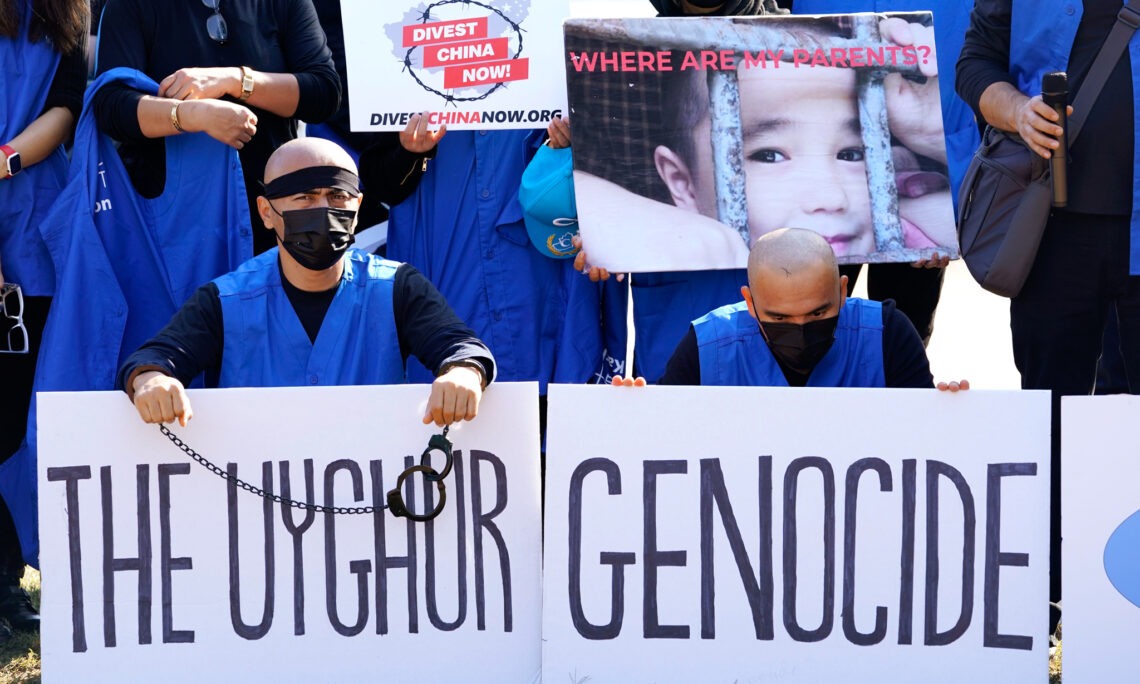- |
- Category: Publications
- |
- Category: Publications
The Budapest Centre for Mass Atrocities Prevention invites you to check out this interview to Dr. Gyorgy Tatar, the Director of the Centre and Chair of the Board of Trustees, on the Uyghur Genocide - following the last report published by the Newlines Institute for Strategy and Policy.
The interviewer is Laura Pistarini Teixeira Nunes - an intern both at the Budapest Centre and the Institute for Cultural Relations Policy - who has written her master's dissertation on the persecution of Uyghurs in China.
You can find both the interview and her short article in the following link:
http://culturalrelations.org/mass-atrocities-in-xinjiang-specificities-and-international-response/
- |
- Category: News
- |
- Category: News
The Budapest Centre for Mass Atrocities Prevention thereby urges the International Community to take all appropriate measures discussed in the document to tackle the Uyghur Genocide and prevent further escalation.
Click here to download the essay.

- |
- Category: News
- |
- Category: News
Applications must be submitted by 31/05/2021.
You can find further information regarding the position and how to apply here.
- |
- Category: Events
- |
- Category: Events
The international community has been brought together to take a stand in the Uyghur Question on this occasion, and some of the propositions and requests consisted of: a tougher response on the part of the UN over China in order to take steps to solve the issue, including a more present stance by the Human Rights Council, the Office of the United Nations High Commissioner, and the General Assembly; the imposition of an international and independent investigative mechanism in order to examine and monitor human rights violations in the region and hold perpetrators accountable; the end of importation from Xinjiang to avoid financing abuses.
The position of the speakers can be efficiently summarized by the words of Agnès Callamard, current Secretary-General of Amnesty International, who stressed that silence regarding the situation in the Xinjiang Uyghur Autonomous Region “tarnishes the human rights system, weakens the UN overall and betrays our duty to the people of China”.
You can find the full discussion in the link http://webtv.un.org/meetings-events/watch/high-level-virtual-event-on-the-situation-of-uyghurs-and-other-turkic-muslim-minorities-in-xinjiang/6253877575001/?term=.
- |
- Category: News
- |
- Category: News
Regrettably, the UN Security Council has not learned the lessons of the genocide committed against the Rohingya people in 2016: its statement released yesterday fails to decide on taking prompt and effective steps for preventing the escalation of the crisis and protecting the population of Myanmar from mass atrocity crimes.
HWPL Statement on Human Rights Crisis in Myanmar

Joint Statement by Alice Wairimu Nderitu, United Nations Special Adviser on the Prevention of Genocide, and Michelle Bachelet, the High Commissioner for Human Rights, on the situation in Myanmar

- |
- Category: Publications
- |
- Category: Publications
Throughout the twentieth century, genocide became a frequent occurrence with millions massacred. This has continued into the twentieth-first century, where perpetrators engage in the intentional mass killing of particular groups in society. Such events are not sudden occurrences but take place under particular circumstances developed over time.
To help recognize the evolution of genocidal processes and prevent future tragedies, American scholar Gregory H. Stanton developed the theory of “ten stages of genocide,” which describe the different stages leading up to a genocide. The stages are as follows: (1) classification; (2) symbolization; (3) discrimination; (4) dehumanization; (5) organization; (6) polarization; (7) preparation; (8) persecution; (9) extermination; and (10) denial. This process is not necessarily linear, and stages may occur in parallel to each other.
The authors of the article attempt to demonstrate the role that artificial intelligence (AI) can play throughout that process in terms of how it can exacerbate the situation or prevent its escalation. In particular, AI in relation to (1) the media and (2) surveillance is discussed given that both appear to be the most common features within the ten stages. While there are of course other AI tools that may be employed throughout the genocidal process, they will not be the focus of the paper. The paper merely attempts to introduce its readers to and raise awareness of the ten stages of genocide, providing a detailed overview of said stages, in addition to how AI vis-à-vis the media and surveillance may play a role in the process.
The article is the third piece in the series of reflections, prepared by the group of interns of the Budapest Centre, which aims to illustrate the role of AI in fighting mass atrocities. The authors hope that the document will also contribute to the research planned by the Budapest Centre within the Initiative “Multipolar Task Force.”
Read more by following the link
- |
- Category: Publications
- |
- Category: Publications
Artificial intelligence (AI) is becoming commonplace in every aspect of society at an accelerating rate, employed in civilian industries such as healthcare and education but also for military means. While there are several benefits to such a trend, the rise of AI does not come without challenges.
A paper was published by the Budapest Centre recently on the security risks related to the rise of AI in the context of mass atrocities. This second paper of the series aims to provide an overview of the policies and recommendations made by international and regional organizations in this realm. Building upon this, the paper concludes that the majority of the eight well-known organizations addressed in the paper do not tackle the challenges from a security perspective.
The Budapest Center for Mass Atrocities Prevention, therefore, pushes these organizations to look closer at concrete actions in the field of AI and mass atrocities they could take by articulating policies and recommendations that governments should take on this topic. The paper predominantly targets young people to introduce them to the topic of mass atrocities in relation to AI; however, academics are welcome to utilize this work for their purposes. The authors hope that the document will also contribute to the research planned by the Budapest Centre within the Initiative “Multipolar Task Force.”
Read more by following the link
- |
- Category: Publications
- |
- Category: Publications
Artificial intelligence (AI) is becoming commonplace in every aspect of society at an accelerating rate. However, the rise of AI does not come without challenges. The aim of this paper, therefore, is to raise awareness of some risks AI represents in the context of mass atrocities. The list is non-exhaustive. It includes the exploitation of sensitive data, the question of ethics, cybercrime and warfare, programmes and models run by AI. The paper is written by the team of interns in the Budapest Centre and it mainly targets young people to introduce them to the topic of mass atrocities in relation to AI; however, we also welcome academics to utilize this work for their purposes.
The authors hope that the document will also contribute to the research planned by the Budapest Centre within the Initiative “Multipolar Task Force.”
Read more by following the link





